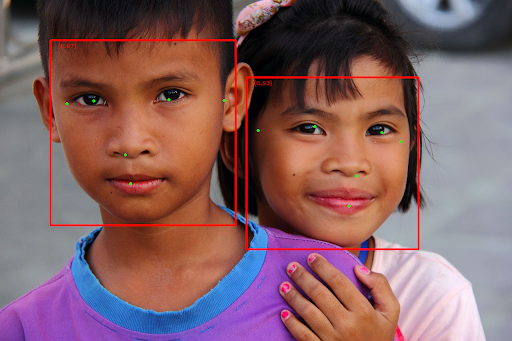The MediaPipe Face Detector task lets you detect faces in an image or video. You can use this task to locate faces and facial features within a frame. This task uses a machine learning (ML) model that works with single images or a continuous stream of images. The task outputs face locations, along with the following facial key points: left eye, right eye, nose tip, mouth, left eye tragion, and right eye tragion.
These instructions show you how to use the Face Detector for web and JavaScript apps. For more information about the capabilities, models, and configuration options of this task, see the Overview.
Code example
The example code for Face Detector provides a complete implementation of this task in JavaScript for your reference. This code helps you test this task and get started on building your own face detection app. You can view, run, and edit the Face Detector example code using just your web browser.
Setup
This section describes key steps for setting up your development environment specifically to use Face Detector. For general information on setting up your web and JavaScript development environment, including platform version requirements, see the Setup guide for web.
JavaScript packages
Face Detector code is available through the MediaPipe @mediapipe/tasks-vision
NPM package. You can
find and download these libraries by following the instructions in the platform
Setup guide.
You can install the required packages through NPM using the following command:
npm install @mediapipe/tasks-vision
If you want to import the task code via a content delivery network (CDN) service, add the following code in the <head> tag in your HTML file:
<!-- You can replace JSDeliver with another CDN if you prefer to -->
<head>
<script src="https://cdn.jsdelivr.net/npm/@mediapipe/tasks-vision/vision_bundle.js"
crossorigin="anonymous"></script>
</head>
Model
The MediaPipe Face Detector task requires a trained model that is compatible with this task. For more information on available trained models for Face Detector, see the task overview Models section.
Select and download a model, and then store it within your project directory:
<dev-project-root>/app/shared/models/
Create the task
Use one of the Face Detector createFrom...() functions to
prepare the task for running inferences. Use the createFromModelPath()
function with a relative or absolute path to the trained model file.
If your model is already loaded into memory, you can use the
createFromModelBuffer() method.
The code example below demonstrates using the createFromOptions() function to
set up the task. The createFromOptions function allows you to customize the
Face Detector with configuration options. For more information on configuration
options, see Configuration options.
The following code demonstrates how to build and configure the task with custom options:
const vision = await FilesetResolver.forVisionTasks(
// path/to/wasm/root
"https://cdn.jsdelivr.net/npm/@mediapipe/tasks-vision@latest/wasm"
);
const facedetector = await FaceDetector.createFromOptions(
vision,
{
baseOptions: {
modelAssetPath: "path/to/model"
},
runningMode: runningMode
});
Configuration options
This task has the following configuration options for Web and JavaScript applications:
| Option Name | Description | Value Range | Default Value |
|---|---|---|---|
option_var_1_web_js |
Sets the running mode for the task. There are two
modes: IMAGE: The mode for single image inputs. VIDEO: The mode for decoded frames of a video or on a livestream of input data, such as from a camera. |
{IMAGE, VIDEO} |
IMAGE |
minDetectionConfidence |
The minimum confidence score for the face detection to be considered successful. | Float [0,1] |
0.5 |
minSuppressionThreshold |
The minimum non-maximum-suppression threshold for face detection to be considered overlapped. | Float [0,1] |
0.3 |
Prepare data
Face Detector can detect faces in images in any format supported by the host browser. The task also handles data input preprocessing, including resizing, rotation and value normalization. To detect faces in videos, you can use the API to quickly process one frame at a time, using the timestamp of the frame to determine when the faces occur within the video.
Run the task
The Face Detector uses the detect() (with running mode image) and
detectForVideo() (with running mode video) methods to trigger
inferences. The task processes the data, attempts to detect faces, and
then reports the results.
Calls to the Face Detector detect() and detectForVideo() methods run
synchronously and block the user interface thread. If you detect faces
in video frames from a device's camera, each detection blocks the main
thread. You can prevent this by implementing web workers to run the detect()
and detectForVideo() methods on another thread.
The following code demonstrates how execute the processing with the task model:
Image
const image = document.getElementById("image") as HTMLImageElement; const faceDetectorResult = faceDetector.detect(image);
Video
await faceDetector.setOptions({ runningMode: "video" }); let lastVideoTime = -1; function renderLoop(): void { const video = document.getElementById("video"); if (video.currentTime !== lastVideoTime) { const detections = faceDetector.detectForVideo(video); processResults(detections); lastVideoTime = video.currentTime; } requestAnimationFrame(() => { renderLoop(); }); }
For a more complete implementation of running an Face Detector task, see the code example.
Handle and display results
The Face Detector generates a face detector result object for each detection run. The result object contains faces in image coordinates and faces in world coordinates.
The following shows an example of the output data from this task:
FaceDetectionResult:
Detections:
Detection #0:
BoundingBox:
origin_x: 126
origin_y: 100
width: 463
height: 463
Categories:
Category #0:
index: 0
score: 0.9729152917861938
NormalizedKeypoints:
NormalizedKeypoint #0:
x: 0.18298381567001343
y: 0.2961040139198303
NormalizedKeypoint #1:
x: 0.3302789330482483
y: 0.29289937019348145
... (6 keypoints for each face)
Detection #1:
BoundingBox:
origin_x: 616
origin_y: 193
width: 430
height: 430
Categories:
Category #0:
index: 0
score: 0.9251380562782288
NormalizedKeypoints:
NormalizedKeypoint #0:
x: 0.6151331663131714
y: 0.3713381886482239
NormalizedKeypoint #1:
x: 0.7460576295852661
y: 0.38825345039367676
... (6 keypoints for each face)
The following image shows a visualization of the task output:

For the image without bounding boxes, see the original image.
The Face Detector example code demonstrates how to display the results returned from the task, see the code example
